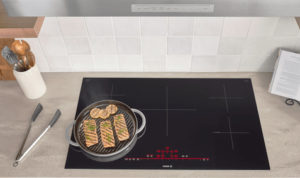
Glass cooktops look sleek in any kitchen and are relatively easy to clean, especially when compared to regular gas burner stoves or electric stoves with drip pans. Unlike them, glass cooktops are smooth and do not have nooks and crannies to collect burned or spilled food. It can be wiped away easily.
You probably did not know that glass cooktops are not actually glass. It is, in fact, a ceramic and glass blend or a polycrystalline material creating a strong surface that can withstand quick and drastic temperature changes. The cooktop is usually black or white and can be transparent or opaque. Most cooktops use radiant heating coils, which allow the burner to heat up while keeping the surrounding surfaces cool. This is due to the cooktops’ low heat conduction coefficient.
You can clean your glass cooktop with just a few simple cleaning products. By regularly wiping your glass cooktop you will ensure that it is clean and good-looking. Even though it is very durable, glass can scratch if pots and pans are dragged around on it, and it can also break if hit hard with a blunt object.
It is best if you clean your glass cooktop after every use. If you regularly remove spills and burned-on foods, you can prevent buildup from happening. If you skip this step, the grime and grease that has spilled on the cooktop will bake and harden from the heat exposure. That will make it much harder to remove. You should thoroughly clean your glass cooktop at least once a week.
- Let your stovetop cool down – Turn off all controls and let your stove cool down completely before attempting to clean it. It is important that you do not clean your stovetop when it’s hot since the heat may prevent the cleaning solution from being effective and you may also hurt yourself.
- Mix a cleaning solution – You can use a commercial cooktop cleaner containing degreasing agents but you can also make your own and we will show you how. Mix one cup of water and one cup of vinegar in a spray bottle. Add one-half teaspoon of dishwashing liquid that contains a degreasing agent. You can use this solution to wipe your cooktop clean after every use.
- Spray on the cleaner and use a non-abrasive sponge to gently scrub in circular motions. If your stove top is extra greasy, you may want to let the solution sit on the surface for a few minutes.
- Rinse and dry – Dip the sponge in plain water and wipe away any soapy residue. Rinsing away the soapy residue is important since it may also bake or burn on the stovetop. Finish by buffing the area dry with a microfiber cloth. That way you will polish the surface and prevent streaks.
- Remove tough stains – If there are any areas with burned-on food, they may require more effort. Start by using a gentle abrasive cleaner before moving to harsher solutions. Apply white vinegar to the area, then sprinkle with baking soda. This mixture will foam. Soak a microfiber cloth in hot water and wring it until it is slightly wet. Cover the vinegar and soda with the cloth and let it sit for 15 minutes. Remove the cloth and use a soft non-abrasive sponge to rub it. The baking soda will work as a gentle abrasive. Wipe away any solids. Repeat the steps if necessary. In the end, dip a clean microfiber cloth in plain water, squeeze out the excess moisture and wipe the whole surface.
- Scrape away any burned food particles – For extra stubborn stains, use a thin plastic scraper to remove them. Wet a microfiber cloth with hot water, wring it until it’s damp, and place it on the stain. It will soften the grime and make it easier to scrape off. For larger chunks of burnt food, work in layers to prevent scratching or damage to the surface. Once you remove the solids, give your glass cooktop a wipe with the vinegar and soap solution. Dry with a lint-free microfiber cloth to prevent streaking.
Generally, as long as you regularly wipe down your cooktop and don’t let the food burn on it and build up, thorough cleaning should be easier. Make sure the pots you place on it are clean and make sure you don’t scratch the stove with them. Even the tiniest scratches on the surface of your glass stovetop will trap food and cause more grime to occur. Disinfect your stovetop once a week to ensure that it is not only clean but also healthy.
It is best if you wipe away any food spills as soon as they happen. By letting them stay, you will allow them to harden and become tough to remove.
